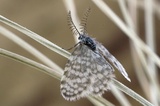Whittleia retiella (Newman, 1847) Species
Last modified: Nov. 22, 2024, 12:58 p.m.
A very rare and extremely local species occurring in WV in Belgium, recorded for the first time in 2008.
Difficult to detect because of its cryptic lifestyle.
Details
- Classification
- Family: Psychidae > Subfamily: Epichnopteriginae > Tribus: Epichnopterigini > Genus: Whittleia > Species: Whittleia retiella
- Vernacular names
- Kustzakdrager (NL), Salzwiesen-Sackträger (DE)
- First mention in Belgium
- Jansen M. G. M. 2008. The Lepidoptera of the salt marshes of Het Zwin including two species new for the Belgian fauna (Lepidoptera). — Phegea 36(3): 109–118. On page 114 (as Whittleia retiella (Newman, 1847)). view page
- Status
-
Native
Distribution
Case
Length 5–8 mm, longitudinally covered with grass blades.
Bionomics
The larva attaches its case firmly to grass and is very difficult to detect. Pupation takes place affixed to grasses.
Males tend to attach their case lower on the grass than females do. Males tend to fly very low over the vegetation in sunshine.
Flight periods
One generation a year from mid-April till June with a peak in the first decade of May.
Observed on
- Host plant (species):
- Puccinellia maritima
- Substrates:
- Grasses and Herbaceous plants
Oligophagous on grasses [Poaceae] like Festuca rubra and Puccinellia maritima , though in other countries the larva has been found on a variety of herbs.
Habitat
Grassy salt-marshes and meadows.






